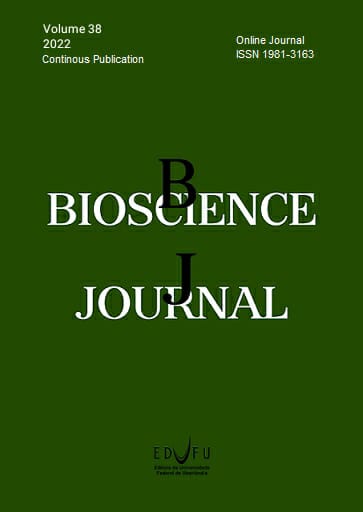Vertical migration of Haemonchus sp. infectant larvae on Stylosanthes spp. and Brachiaria brizantha (Syn. Urochloa brizantha) cv. Marandu forage
DOI:
https://doi.org/10.14393/BJ-v38n0a2022-53801Keywords:
Brachiaria, Haemonchus, Infectant Larvae, Parasite Control, Trichostrongyloidea.Abstract
The present work aimed to evaluate the influence of Stylosanthes spp. (Campo Grande© styles) and Brachiaria brizantha cv. Marandu in the vertical migration of Haemonchus spp. infective larvae, in the region of Uberlândia, Minas Gerais. Seeds of Stylosanthes spp. and Brachiaria brizantha cv. Marandu were planted in 50 pots of five liters (20 cm diameter) evenly disposed in an area of the Capim Branco Experimental Farm, Federal University of Uberlândia. When both species reached the minimum height of 20 cm, the pots were experimentally contaminated with sheep feces coprocultures. Samplings were performed, with complete removal of the vegetal material contained in the pots, on days one, three, six, 10 and 14 after contamination. Nematoids were recovered from the plant samples by thermo and hydrotropism, counted under an optical microscope and identified. For statistical analysis, the data were analyzed in a completely randomized design (DIC) in a 2X5 factorial scheme (two fodder species X 5 collection dates). No effect of the forage species was observed on the number of L3 of Haemonchus sp. recovered in the feces (p = 0.7790), upper stratum (p = 0.1755) or lower stratum (p = 0.7883) of the forage, however, there was a significant decrease in the number of L3 found with the passing of the days. When comparing the mean L3 recovered in the upper (0.06±0.31 L3) and lower (2.94±0.39) strata, a higher number of larvae was observed in the lower stratum (p < 0.0001). Therefore, in both forage species studied, the upper stratum of the plants, preferably pastured by the animals, remained with less contamination of infective larvae and the contamination tended to decrease over the days.
References
ANDRADE, C.M.S., ASSIS, G.M.L. and SALES, M. F. L. Estilosantes Campo Grande leguminosa forrageira recomendada para solos arenosos do Acre. Circular Técnica 55. Rio Branco: Embrapa, 2010. Available from: https://www.infoteca.cnptia.embrapa.br/bitstream/doc/879062/1/Circulartec.55.pdf
ALBUQUERQUE, A.C.A. et al. Development of Haemonchus contortus resistance in sheep under suppressive or targeted selective treatment with monepantel. Veterinary Parasitology. 2017, 246, 112-117. https://doi.org/10.1016/j.vetpar.2017.09.010
BARROS, A.T.M. and EVANS, D.E. Forrageiras Com Potencial Anticarrapato. Ação de Substâncias Voláteis em Larvas Infestantes de Boophilus microplus (Can., 1887). Pesquisa Agropecuária Brasileira. 1991, 26(4),499-503. Available at: http://seer.sct.embrapa.br/index.php/pab/article/view/3369
CARNEIRO, R.D. and AMARANTE, A.F.T. Seasonal effect of three pasture plants species on the free-living stages of Haemonchus contortus. Arquivo Brasileiro de Medicina Veterinária e Zootecnia. 2008, 60(4), 864-872. https://doi.org/10.1590/S0102-09352008000400014
CINTRA, M.C.R. et al. Lack of efficacy of monepantel against Trichostrongylus colubriformis in sheep in Brazil. Veterinary Parasitology. 2016, 216, 4-6. https://doi.org/10.1016/j.vetpar.2015.11.013
CRUZ-VASQUEZ, C. and FERNANDEZ-RUVALCABA, M. Anti-tick repellent effect of Andropogon gayanus grass on plots of different ages experimentally infested with Boophilus microplus larvae. Parasitología al Día. 2000, 24(3-4), 88-91. http://dx.doi.org/10.4067/S0716-07202000000300003
EMBRAPA, Gado de Corte. Cultivo e uso do estilosantes Campo Grande. Comunicado técnico 105. Campo Grande: Embrapa CNPGC, 2007. 10 p. Available from: https://www.infoteca.cnptia.embrapa.br/infoteca/handle/doc/319150
FERNANDES, M.A.M. et al. FAMACHA method for detecting clinical anemia caused by Haemonchus contortus in suckling lambs and lactating ewes. Pesquisa Veterinária Brasileira. 2015, 35(6), 525-530. https://doi.org/10.1590/S0100-736X2015000600006
GAZDA, T. L. et al. Distribution of nematode larvae of sheep in tropical pasture plants. Small Ruminant Research. 2009, 82(2), 94-98. https://doi.org/10.1016/j.smallrumres.2009.02.004
GORDON, H.M.CL. and WHITLOCK, H.V. A New Technique for Counting Nematode Eggs in Sheep Faeces. Journal of the Council for Scientific and Industrial Research. 1954, 12(1), 50–52. Available at: https://publications.csiro.au/rpr/download?pid=procite:21259a33-8a8e-4add-9315-f8338091a3e6&dsid=DS1
MELO, V.F.P. et al. Manejo de anti-helmínticos no controle de infecções gastrintestinais em cabras. Revista Brasileira de Saúde e Produção Animal. 2015, 16(4), 916-924. https://doi.org/10.1590/S1519-99402015000400015
MENDES, J.B. et al. Effects of protein supplementation on resistance and resilience of lambs naturally infected with gastrointestinal parasites. Semina: Ciências Agrárias. 2018, 39(2), p. 643-656. http://dx.doi.org/10.5433/1679-0359.2018v39n2p643
MURO CASTREJÓN, F. et al. Repellence of Boophilus microplus larvae in Stylosanthes humilis and Stylosanthes hamata plants. Parasitologia Lationameriacana. 2003, 58(3-4), 118-121. http://dx.doi.org/10.4067/S0717-77122003000300005
MOLENTO, M. B., BUZATTI, A. and SPRENGER, L. K. Pasture larval count as a supporting method for parasite epidemiology, population dynamic and control in ruminants. Livestock Science. 2016, 192,48–54. https://doi.org/10.1016/j.livsci.2016.08.013
OLIVEIRA, A.L.F. et al. Effect of plant trichomes on the vertical migration of Haemonchus contortus infective larvae on five tropical forages. Tropical Animal Health and Production. 2009, 41(5),775-782. https://doi.org/10.1007/s11250-008-9251-1
RUGAI, E.; MATTOS, T. and BRISOLA, A.P. Nova técnica para isolar larvas de nematóides das fezes-modificação do método de Baermann. Revista do Instituto Adolfo Lutz. 1954, 14, 5-8.
SALGADO, J.A. and SANTOS, C.P. Overview of anthelmintic resistance of gastrointestinal nematodes of small ruminants in Brazil. Revista Brasileira de Parasitologia Veterinária. 2016, 25(1),3-17. https://doi.org/10.1590/S1984-29612016008
SANTOS, M.C., SILVA, B.F. and AMARANTE, A.F.T. Environmental factors influencing the transmission of Haemonchus contortus. Veterinary Parsitology. 2012, 188(3), 277-284. https://doi.org/10.1016/j.vetpar.2012.03.056
TRONCHA, P.M.R. et al. Longevidade de larvas infectantes de Haemonchus sp. em duas alturas de pasto de Brachiaria brizantha cv. Marandu. Revista Medicina Veterinária (UFRPE), 2019, 13(4), 552-558. https://doi.org/10.26605/medvet-v13n4-3664
UENO, H. and GONÇALVES, P.C. Manual para diagnóstico das helmintoses de ruminantes. 4th Ed. J. I. C. A.: Tokyo, Japan, 1998.
VAN WYK, J.A.; CABARET, J. and MICHAEL, L. M. Morphological identification of nematode larvae of small ruminants and cattle simplified. Veterinary Parasitology. 2004, 119(4), 277–306. https://doi.org/10.1016/j.vetpar.2003.11.012
VERÍSSIMO, C.J. et al. Multidrug and multispecies resistance in sheep flocks from Sao Paulo state, Brazil. Veterinary Parasitology. 2012, 187(1-2), 209-216. https://doi.org/10.1016/j.vetpar.2012.01.013
WILMSEN, M.O. et al. Gastrointestinal nematode infections in sheep raised in Botucatu, state of São Paulo, Brazil. Revista Brasileira de Parasitologia Veterinária. 2014, 23(3), 348-354. https://doi.org/10.1590/S1984-29612014058
Downloads
Published
Issue
Section
License
Copyright (c) 2022 Mylla Christhie Costa Urzedo, Manoel Eduardo Rozalino Santos, Ligia Pinho Cuccato, Suyanne Aparecida Silva Macedo, Fernanda Rosalinski-Moraes

This work is licensed under a Creative Commons Attribution 4.0 International License.





